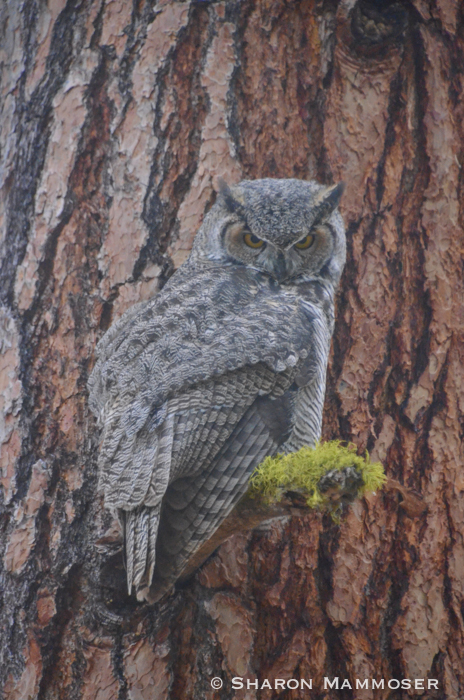Did you recognize the owl from last week’s puzzler? I admit, when I first saw it I was puzzled and had to enlist the help of my birder-husband to identify it. Being in Montana, and not North Carolina, I thought it could be something exotic, maybe some owl I’d never heard of and certainly never seen. We looked through the books, studied the pictures. What was it?

Finally, we decided it is a Great Horned Owl (Bubo virginianus), but what’s called a pale variation. I have seen great horned owls, but they are usually brown, not gray. But depending on where they live, their color does vary in order to be better camouflaged. Did the coloring confuse you too, or did you recognize it, with it’s yellow eyes, barred chest, large size and ear tufts?
Here is a video of the owl– though fair warning– this is rather dull! As the owl just is sitting there the whole time. And no, I don’t know what bird flew over that he was so fixated on! Watch here:
Great horned owls are also called hoot owls or tiger owls,the latter for the barring on their chests. They weigh only 3-4 pounds and at 17-25 inches tall, with a wingspan of 30-50 inches, they are the second largest owl in North America, the first largest being the great gray owl. They are the most widely distributed owl in North and South America.
The lifespan of a great horned owl in the wild is 10-15 years. In captivity, they have been known to live 28 years. Like all owls they have a fabulous sense of sight, and hearing…did you know owl’s ears are not symmetrical, not straight across from each other? One is higher than the other, which combined with their unique circular facial disk, allows them to triangulate their prey. They can pinpoint the location of a mouse from high in the treetops and then silently, swoop down to snag it with their sharp talons. (By the way, the “ear tufts” are a misleading term as they are not ears at all! And have nothing to do with the bird’s hearing. An owl’s ears are small openings in the skull on the sides of their heads that are not visible when you view the owl.)
One cool fact about great horned owls is they can prey on skunks and are not affected by their terrible smell! (Most birds do not have a well-developed sense of smell) Another fact is that, like all owls, they can’t move their eyes in their socket, so to look around, move their whole head–but NO! They CAN’T turn their heads all the way around! This is a myth! They have 14 neck vertebrae that allow them to rotate 270 degrees. By comparison, humans can rotate their necks only 60-80 degrees. (Here is a great article explaining how owls can do this)
Great horned owls do not migrate like many other birds; they remain in the same territory all year. Also, great horned owls are a bit crazy in that they lay their eggs really early–usually weeks or even months before most other raptors. Sometimes this means having eggs in their nest in February, which of course in some locations, means snow is still on the ground and temperatures are chilly. They want to get a head start on things and by the time their babies are ready to fly, spring will have arrived. And speaking of nests, great horned owls (and other owls) do not build nests, instead, they take over an existing nest and make it their own.
And just in case you need one more weird fact for that next dinner party you are planning–great horned owls will usually be-head their larger prey before taking it back to their nest or eating perch. Weight matters I guess!
Have you seen or heard any owls lately?


